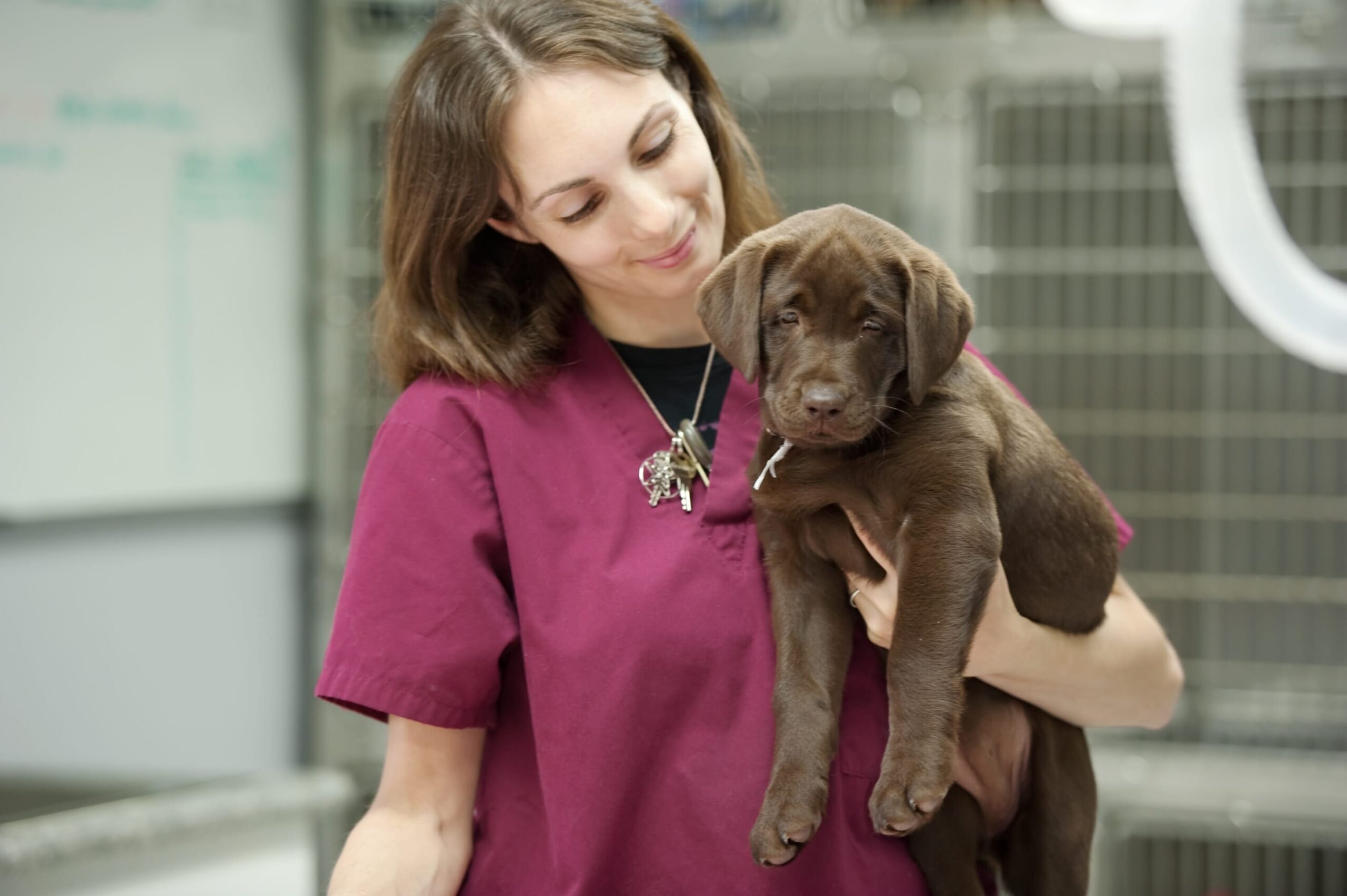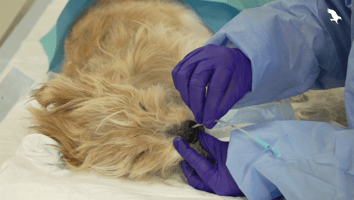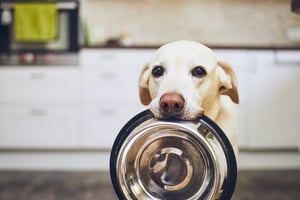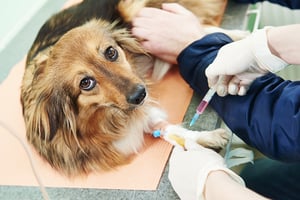Acute diarrhoea is a common complaint seen in first-opinion small animal veterinary practice. Despite the fact that it is often self-limiting and likely to resolve with symptomatic treatment alone, antibiotics are frequently prescribed as part of the therapeutic management plan. In part one of this two-part article we will look at the common causes of acute diarrhoea, including infectious agents, and consider the use of faecal analysis. In part two, we will address when and why antibiotics are used in the management of acute diarrhoea, whether they are truly indicated and the potential adverse effects of antibiotic usage.
Diarrhoea is defined as an increase in frequency, fluidity or volume of faeces and is a common complaint in dogs and cats (Battersby and Harvey, 2006). Diarrhoea can occur secondary to disorders affecting the small or large intestines, or both (Hall, 2009). Localisation to the small or large bowel may not be possible in diffuse disease; it may also be less relevant in acute diarrhoea as biopsies are unlikely to be required and symptomatic treatment may not differ. Diarrhoea lasting for less than two weeks is generally described as acute (Chandler, 2002) and commonly resolves without the requirement for veterinary intervention (Hubbard et al., 2007). Therefore, animals are often presented at the vets due to owner concern or difficulty in managing the symptoms.
In terms of prevalence, one study found that 14.9 percent of dogs had experienced an episode of diarrhoea within the previous two-week period (Hubbard et al., 2007); another reported 28.6 percent of dogs visiting the vets had diarrhoea as their presenting complaint or had experienced an episode of diarrhoea within the previous month (Stavisky et al., 2010). Data from pet cats is limited, but one study showed that prevalence of diarrhoea in a rescue cat population was 11.9 percent (German et al., 2017).
Common causes of acute diarrhoea
Given the often self-limiting nature of acute diarrhoea, an exact aetiology is not always established. However, common causes of acute gastrointestinal upset include dietary indiscretion, dietary intolerance, sudden change in dietary composition, infectious organisms, anatomical abnormalities (eg intussusception), toxin exposure and metabolic or systemic disease (Table 1).
| INFECTIOUS | Parasites - Toxocara spp., Taenia spp., Dipylidium caninum, Trichuris vulpis, Uncinaria stenocephala Protozoa - Giardia, Cryptosporidium, Coccidia, Isospora, Tritrichomonas foetus Bacterial - Salmonella spp., pathogenic E. coli, Campylobacter jejuni, Clostridium difficile, Clostridium perfringens, Yersinia spp. Viral - parvovirus, coronavirus, FeLV, FIV, distemper, rotavirus, circovirus, norovirus, canine adenovirus, feline torovirus, reovirus, enteroviruses, feline astrovirus Algal - Prototheca Fungal |
| DIETARY | Sudden diet change, indiscretion (scavenging), hypersensitivity (allergy), intolerance, poor quality diet, mouldy food |
| TOXIN EXPOSURE | Drugs, heavy metals |
| ANATOMICAL | Intussusception |
| ANOMALOUS | Acute haemorrhagic diarrhoea syndrome, acute pancreatitis, obstruction |
| METABOLIC | Hypoadrenocorticism |
Dogs which have experienced a recent change of diet (scavenging or owner administered) or are fed a home-cooked diet, that live in a multi-dog household or have recently stayed in kennels, are at increased risk of diarrhoea (Stavisky et al., 2011). There are other potential causes of diarrhoea which may initially present as acute diarrhoea, but then develop into chronic diarrhoea. While there is some overlap with the causes of acute diarrhoea, an extensive list of differential diagnoses for chronic diarrhoea is beyond the scope of this article.
Infectious causes of acute diarrhoea
There are many potentially pathogenic organisms which may cause or contribute to the development of acute diarrhoea. Given that a healthy gastrointestinal microbiota consists of a diverse mix of microorganisms, including some which are potentially pathogenic, it can be difficult to determine whether the presence of certain microorganisms is of clinical significance in cases of diarrhoea. A North American study investigating the prevalence of enteric pathogens found that 30 percent of faecal samples from dogs with diarrhoea, and 22 percent of faecal samples from healthy dogs, contained potential pathogens (Hackett and Lappin, 2003).
Parasites and protozoa
Parasitic infections tend to be more common in younger animals (ESCCAP, 2018). Identification of worms or their eggs in the faeces of diarrhoeic animals is an indication for treatment with an appropriate endoparasiticide. While protozoal infections can be subclinical (Santín, 2013; Tysnes et al., 2014), diarrhoea may follow heavy infestations, infections in young or immunocompromised animals or infections alongside other pathogens or concurrent disease (Battersby and Harvey, 2006). Clinical manifestations of protozoal disease may require medical management.
Viruses
Various viruses have been associated with acute diarrhoea in dogs and cats. The most commonly detected are parvoviruses, coronaviruses, paramyxoviruses, rotaviruses and caliciviruses (Schulz et al., 2008). Parvovirus and paramyxovirus have been shown to be strongly associated with acute haemorrhagic diarrhoea (Schulz et al., 2008). Parvovirus (type 2) is perhaps the most feared within the UK as it can cause acute, fatal diarrhoea, most commonly in young, unvaccinated dogs (Goddard and Leisewitz, 2019). Since parvovirus requires actively dividing cells to replicate, gastrointestinal and lymphoid tissue are particularly susceptible, resulting in intestinal necrosis and immunosuppression. Parvoviral infection may also lead to permanent changes in the cytoarchitecture of the gut. Severe disruption to the intestinal mucosal barrier may facilitate bacterial translocation, which could result in septicaemia (Goddard and Leisewitz, 2019). The significance of other viral agents in the pathogenesis of acute diarrhoea is less clear, which may be the result of interplay between other predisposing factors. For example, although circoviral infection alone is unlikely to cause acute diarrhoea, it may worsen the prognosis of parvoviral infection (Anderson et al., 2017). Similarly, co-infection with rotavirus has been shown to worsen the clinical signs of parvoviral infections (Ortega et al., 2017). Coronavirus is found more commonly in the stools of healthy animals than those with diarrhoea, but it may cause mild diarrhoea in young animals (Schulz et al., 2008; Tennant et al., 1991; Tupler et al., 2012). The feline retroviruses FeLV and FIV are more commonly associated with chronic diarrhoea but they may also predispose cats to secondary infections, which could have an acute presentation (Cooper, 2011).
Antibiotics are ineffective in the treatment of viruses. However, when considering the use of antibiotics in acute diarrhoea, viral infections become particularly relevant if they are likely to increase the risk of sepsis, for which antibiotics would then be required. This may be via immunosuppression or disruption to the mucosal barrier which could enable translocation of commensal bacteria.
Bacteria
Many potentially enteropathogenic bacteria are detected in the faeces of healthy animals (Table 2), hence their detection in stool samples of patients with diarrhoea may be of questionable clinical significance. Some studies have shown that stools from healthy animals are more likely to contain potentially pathogenic bacteria (eg Campylobacter spp. and Clostridium difficile) than the faeces from diarrhoeic animals (Cave et al., 2002; Sandberg et al., 2002; Stavisky et al., 2011).
| BACTERIA | PREVALENCE IN HEALTHY DOGS | PREVALENCE IN DIARRHOEIC DOGS | PREVALENCE IN HEALTHY CATS | PREVALENCE IN DIARRHOEIC CATS |
| Campylobacter spp. | 21 to 76 percent | 27 to 97 percent | 18 to 55 percent | 16 to 31 percent |
| Clostridium difficile | 10 to 55 percent (up to 94 percent in neonates) | 18 percent | 0 percent | (9.4 percent in hospitalised cats, of which 43 percent had diarrhoea) |
| Clostridium perfringens | 11 to 100 percent | 27 to 87.1 percent | ||
| Salmonella spp. | 3 percent (up to 93 percent if raw fed) | 1.2 to 2.3 percent | 0.36 to 0.8 percent | |
| Enterotoxigenic E. coli | 2.7 percent | |||
| Enteropathogenic E. coli | 14 percent | 35.1 percent acute diarrhoea | Detected | |
| Verotoxigenic E. coli | 1.6 percent | 24.6 percent acute diarrhoea | Detected | Detected |
Even when bacteria have been cultured from stools, further tests are likely to be required to identify whether or not the isolated strain is pathogenic. For example, there are many commensal, non-pathogenic strains of E. coli, yet others (Table 2) may be associated with severe disease. Specific toxins or genes need to be identified to ascertain whether an individual E. coli strain is pathogenic because a positive culture alone is not sufficient for diagnosis (Marks and Kather, 2003; Hall, 2009). Campylobacter jejuni and Campylobacter coli may be pathogenic in dogs, yet Campylobacter upsaliensis, the most common isolate from dogs, is not thought to be (Hald et al., 2004). Identification of specific Campylobacter species requires molecular based techniques such as PCR (Marks and Kather, 2003), which are not routinely carried out at faecal analysis.
With other bacteria, such as Clostridium spp., detection of specific toxins produced by pathogenic strains may be more relevant than isolating the bacteria themselves. One study found no significant difference in the likelihood of isolating Clostridium difficile or Clostridium perfringens between healthy and diarrhoeic dogs (Marks et al., 2002), and while Clostridium perfringens enterotoxin (CPE) and Clostridium difficile toxins A and B are more likely to be found in the stools of diarrhoeic dogs, they have also been detected in stools from healthy dogs (Cave et al., 2002; Marks et al., 2002; Weese et al., 2001). This means that even if these toxins are isolated from the faeces of diarrhoeic patients, it is very difficult to be certain that they are the cause of the diarrhoea.
Finally, given that any change to the gastrointestinal environment can result in alterations to the microbiota (termed dysbiosis), it is possible that an increased prevalence of certain microorganisms may be caused by, rather than causative of, acute diarrhoea.
It is possible that an increased prevalence of certain microorganisms may be caused by, rather than causative of, acute diarrhoea
Faecal panels – what are we testing for?
By definition, acute diarrhoea will resolve, with or without treatment, within two weeks (Chandler, 2002). Diagnostic testing is therefore infrequently carried out. A study using data from the Small Animal Veterinary Surveillance Network (SAVSNET) reported that diagnostic tests were performed in only 16 percent of cases with diarrhoea that were seen in general practice. The most common tests performed were blood tests (haematology and biochemistry) and faecal analysis (parasitology and bacteriology) (Jones et al., 2014). Another recent study reported that faecal analysis was carried out in 7.8 percent of dogs and 6.8 percent of cats presenting with diarrhoea (Singleton et al., 2019). One author writing about the management of diarrhoea in cats recommended reserving faecal cultures for cats which develop sudden-onset, acute, bloody diarrhoea with evidence of sepsis; cats which develop diarrhoea after kennelling or shows; or when multiple cats from one household are affected (Marks, 2000). These seem reasonable considerations for faecal culture as they are situations more suggestive of potential bacterial infection, although viral, protozoal and parasitic infections should also be considered.
The aim of faecal analysis in cases of acute diarrhoea is to identify the presence of infectious agents to guide treatment or to provide prognostic information. There is no doubt that detection of parasites or protozoa will often indicate that certain treatments are required, or that isolation of certain viruses (eg parvovirus) will help the clinician to provide prognostic guidance for the owner. However, given that Salmonella, Campylobacter, Yersinia (Fukushima et al., 1984; Fantasia et al., 1985) and E. coli O157 (Beutin, 1999) have all been isolated from healthy animals (Table 2), detection of these bacteria in faecal samples does not necessarily confirm the cause of the diarrhoea. All of these bacteria are zoonotic, so testing may be indicated if there is concern regarding zoonotic disease within a household (eg presence of children, immunocompromised people or owners with significant symptoms themselves). However, as we will discuss in more detail in part two, the use of antibiotics solely to try to achieve elimination of these bacteria from the pet’s stool samples is questionable (Weese, 2011).
Summary
Part one of this two-part series investigated the potential causes for acute diarrhoea and how difficult it can be to ascertain whether isolation of potentially pathogenic bacteria, from the stools of dogs with acute diarrhoea, is of clinical relevance to an individual patient. Part two will address when and why antibiotics are currently prescribed for acute diarrhoea, whether they are truly indicated and the potential adverse effects of their use.
References (click to expand)
| Acke, E., McGill, K., Golden, O., Jones, B., Fanning, S. and Whyte, P. | 2009 | Prevalence of thermophilic Campylobacter species in household cats and dogs in Ireland. Veterinary Record, 164, 44-47 |
| Al Saif, N. and Brazier, J. | 1996 | The distribution of Clostridium difficile in the environment of South Wales. Journal of Medical Microbiology, 45, 133-137 |
| Anderson, A., Hartmann, K., Leutenegger, C., Proksch, A., Mueller, R. and Unterer, S. | 2017 | Role of canine circovirus in dogs with acute haemorrhagic diarrhoea. Veterinary Record, 180, 542-542 |
| Battersby, I. and Harvey, A. | 2006 | Differential diagnosis and treatment of acute diarrhoea in the dog and cat. In Practice, 28, 480-488 |
| Beutin, L. | 1999 | Escherichia coli as a pathogen in dogs and cats. Vet Research, 30, 285-298 |
| Borriello, S., Honour, P., Turner, T. and Barclay, F. | 1983 | Household pets as a potential reservoir for Clostridium difficile infection. Journal of Clinical Pathology, 36, 84-87 |
| Burnens, A., Angéloz-Wick, B. and Nicolet, J. | 1992 | Comparison of Campylobacter carriage rates in diarrheic and healthy pet animals. Journal of Veterinary Medicine, Series B, 39, 175-180 |
| Cassutto, B. and Cook, L. | 2002 | An Epidemiological Survey of Clostridium perfringens-associated enterotoxemia at an army veterinary Treatment Facility. Military Medicine, 167, 219-222 |
| Cave, N., Marks S., Kass P., Melli A. and Brophy M. | 2002 | Evaluation of a routine diagnostic fecal panel for dogs with diarrhea. Journal of the American Veterinary Medical Association, 221, 52–59 |
| Chaban, B., Ngeleka, M. and Hill, J. | 2010 | Detection and quantification of 14 Campylobacter species in pet dogs reveals an increase in species richness in feces of diarrheic animals. BMC Microbiology, 10, 73 |
| Chandler, M. | 2002 | The chronically diarrhoeic dog. In Practice, 24, 18–27 |
| Clooten, J., Kruth, S., Arroyo, L. and Weese, J. | 2008 | Prevalence and risk factors for Clostridium difficile colonization in dogs and cats hospitalized in an intensive care unit. Veterinary Microbiology, 129, 209-214 |
| Cooper, S. | 2011 | Recurrent diarrhoea in cats. In Practice, 33, 272-281 |
| Engvall, E., Brändström, B., Andersson, L., Båverud, V., Trowald-Wigh, G. and Englund, L. | 2003 | Isolation and identification of thermophilic Campylobacter species in faecal samples from swedish dogs. Scandinavian Journal of Infectious Diseases, 35, 713-718 |
| ESCCAP (European Scientific Counsel companion animal parasites) | 2018 | Guideline 06 - Control of intestinal protozoa in dogs and cats, Edition 2. Malvern: ESCCAP, 4 |
| Fantasia, M., Grazia Mingrone, M., Crotti, D. and Boscato, C. | 1985 | Isolation of Yersinia enterocolitica biotype 4 serotype O3 from canine sources in Italy. Journal of Clinical Microbiology, 22, 314-315 |
| Fukushima, H., Nakamura, R., Iitsuka, S., Tsubokura, M., Otsuki, K. and Kawaoka, Y. | 1984 | Prospective systematic study of Yersinia spp. in dogs. Journal of Clinical Microbiology, 19, 616-622 |
| German, A., Cunliffe, N. and Morgan, K. | 2016 | Faecal consistency and risk factors for diarrhoea and constipation in cats in UK rehoming shelters. Journal of Feline Medicine and Surgery, 19, 57-65 |
| Goddard, A. and Leisewitz, A. | 2010 | Canine Parvovirus. The Veterinary Clinics of North America. Small Animal Practice, 40, 1041–1053 |
| Hackett, T. and Lappin, M. | 2003 | Prevalence of Enteric Pathogens in Dogs of North-Central Colorado. Journal of the American Animal Hospital Association, 39, 52-56 |
| Hald, B. and Madsen, M. | 1997 | Healthy puppies and kittens as carriers of Campylobacter spp., with special reference to Campylobacter upsaliensis. Journal of clinical microbiology, 35, 3351-3352 |
| Hald, B., Pedersen, K., Waino, M., Jorgensen, J. and Madsen, M. | 2004 | Longitudinal study of the excretion patterns of thermophilic Campylobacter spp. in young pet dogs in Denmark. Journal of Clinical Microbiology, 42(5), pp.2003-2012 |
| Hall, E. | 2009 | Canine diarrhoea: a rational approach to diagnostic and therapeutic dilemmas. In Practice, 31, 8-16 |
| Hall, E. and Day, M. | 2017 | Disease of the small intestine. In: E. Ettinger, E. Feldman and E. Côté, ed., Textbook of Veterinary Internal Medicine, 8th ed. St Louis, Missouri: Elsevier, 1516-1592 |
| Hubbard, K., Skelly, B., McKelvie, J. and Wood, J. | 2007 | Risk of vomiting and diarrhoea in dogs. Veterinary Record, 161, 755-757 |
| Joffe, D. and Schlesinger, D. | 2002 | Preliminary assessment of the risk of Salmonella infection in dogs fed raw chicken diets. The Canadian Veterinary Journal, 43, 441-442 |
| Jones, P., Dawson, S., Gaskell, R., Coyne, K., Tierney, Á., Setzkorn, C., Radford, A. and Noble, P. | 2014 | Surveillance of diarrhoea in small animal practice through the Small Animal Veterinary Surveillance Network (SAVSNET). The Veterinary Journal, 201, 412-418 |
| Langlois, D., Koenigshof, A. and Mani, R. | 2019 | Metronidazole treatment of acute diarrhea in dogs: a randomized double blinded placebo‐controlled clinical trial. Journal of Veterinary Internal Medicine, 34, 98-104 |
| Lefebvre, S., Waltner-Toews, D., Peregrine, A., Reid-Smith, R., Hodge, L., Arroyo, L. and Weese, J. | 2006 | Prevalence of zoonotic agents in dogs visiting hospitalized people in Ontario: implications for infection control. Journal of Hospital Infection, 62, 458-466 |
| Madewell, B., Bea, J., Kraegel, S., Winthrop, M., Tang, Y. and Silva, J. | 1999 | Clostridium Difficile: a survey of fecal carriage in cats in a veterinary medical teaching hospital. Journal of Veterinary Diagnostic Investigation, 11, 50-54 |
| Marks, S. and Kather, E. | 2003 | Bacterial-associated diarrhea in the dog: a critical appraisal. Veterinary Clinics of North America: Small Animal Practice, 33, 1029-1060 |
| Marks, S. | 2000 | Diagnostic and therapeutic approach to cats with chronic diarrhoea. Journal of Feline Medicine and Surgery, 2, 105-109 |
| Marks, S., Kather, E., Kass, P. and Melli, A. | 2002 | Genotypic and phenotypic characterization of Clostridium perfringens and Clostridium difficile in diarrheic and healthy dogs. Journal of Veterinary Internal Medicine, 16, 533 |
| McKenzie, E., Riehl, J., Banse, H., Kass, P., Nelson, Jr, S. and Marks, S. | 2010 | Prevalence of diarrhea and enteropathogens in racing sled dogs. Journal of Veterinary Internal Medicine, 24, 97-103 |
| Morley, P., Strohmeyer, R., Tankson, J., Hyatt, D., Dargatz, D. and Fedorka-Cray, P. | 2006 | Evaluation of the association between feeding raw meat and Salmonella enterica infections at a Greyhound breeding facility. Journal of the American Veterinary Medical Association, 228, 1524-1532 |
| Olson, P., Hedhammar, Å., Faris, A., Krovacek, K. and Wadström, T. | 1985 | Enterotoxigenic Escherichia coli (ETEC) and Klebsiella pneumoniae isolated from dogs with diarrhoea. Veterinary Microbiology, 10, 577-589 |
| Ortega, A., Martínez-Castañeda, J., Bautista-Gómez, L., Muñoz, R. and Hernández, I. | 2017 | Identification of co-infection by rotavirus and parvovirus in dogs with gastroenteritis in Mexico. Brazilian Journal of Microbiology, 48(4), pp.769-773 |
| Parsons, B., Porter, C., Ryvar, R., Stavisky, J., Williams, N., Pinchbeck, G., Birtles, R., Christley, R., German, A., Radford, A., Hart, C., Gaskell, R. and Dawson, S. | 2010 | Prevalence of Campylobacter spp. in a cross-sectional study of dogs attending veterinary practices in the UK and risk indicators associated with shedding. The Veterinary Journal, 184, 66-70 |
| Perrin, J., Buogo, C., Gallusser, A., Burnens, A. and Nicolet, J. | 1993 | Intestinal carriage of Clostridium difficile in neonate dogs. Journal of Veterinary Medicine, Series B, 40, 222-226 |
| Pospischil, A., Mainil, J., Baljer, G. and Moon, H. | 1987 | Attaching and effacing bacteria in the intestines of calves and cats with diarrhea. Veterinary Pathology, 24, 330-334 |
| Riley, T., Adams, J., O'Neill, G. and Bowman, R. | 1991 | Gastrointestinal carriage of Clostridium difficile in cats and dogs attending veterinary clinics. Epidemiology and Infection, 107, 659-665 |
| Rossi, M., Hänninen, M., Revez, J., Hannula, M. and Zanoni, R. | 2008 | Occurrence and species level diagnostics of Campylobacter spp., enteric Helicobacter spp. and Anaerobiospirillum spp. in healthy and diarrheic dogs and cats. Veterinary Microbiology, 129, 304-314 |
| Sancak, A., Rutgers, H., Hart, C. and Batt, R. | 2004 | Prevalence of enteropathic Escherichia coli in dogs with acute and chronic diarrhoea. Veterinary Record, 154, 101-106 |
| Sandberg, M., Bergsjø, B., Hofshagen, M., Skjerve, E. and Kruse, H. | 2002 | Risk factors for Campylobacter infection in Norwegian cats and dogs. Preventive Veterinary Medicine, 55, 241-253 |
| Santín, M. | 2013 | Clinical and subclinical infections with Cryptosporidium in animals. New Zealand Veterinary Journal, 61, 1-10 |
| Schulz, B., Strauch, C., Mueller, R., Eichhorn, W. and Hartmann, K. | 2008 | Comparison of the prevalence of enteric viruses in healthy dogs and those with acute haemorrhagic diarrhoea by electron microscopy. Journal of Small Animal Practice, 49(2), 84-88 |
| Singleton, D., Arsevska, E., Smyth, S., Barker, E., Jewell, C., Brant, B., Sánchez-Vizcaíno, F., Dawson, S., Pinchbeck, G., Noble, P., Jones, P. and Radford, A. | 2019 | Small animal disease surveillance: gastrointestinal disease, antibacterial prescription and Tritrichomonas foetus. Veterinary Record, 184, 211-216 |
| Smith, K., Kruth, S., Hammermueller, J., Gyles, C. and Wilson, J. | 1998 | ) A case-control study of verocytotoxigenic Escherichia coli infection in cats with diarrhea. Canadian Journal of Veterinary Research, 62, 87-92 |
| Spain, C., Scarlett, J., Wade, S. and McDonough, P. | 2001 | Prevalence of enteric zoonotic agents in cats less than 1 year old in Central New York State. Journal of Veterinary Internal Medicine, 15, 33-38 |
| Stavisky, J., Pinchbeck, G., German, A., Dawson, S., Gaskell, R., Ryvar, R. and Radford, A. | 2010 | Prevalence of canine enteric coronavirus in a cross-sectional survey of dogs presenting at veterinary practices. Veterinary Microbiology, 140, 18-24 |
| Stavisky, J., Radford, A., Gaskell, R., Dawson, S., German, A., Parsons, B., Clegg, S., Newman, J. and Pinchbeck, G. | 2011 | A case–control study of pathogen and lifestyle risk factors for diarrhoea in dogs. Preventive Veterinary Medicine, 99, 185-192 |
| Tennant, B., Gaskell, R., Kelly, D., Carter, S. and Gaskell, C. | 1991 | Canine coronavirus infection in the dog following oronasal inoculation. Research in Veterinary Science, 51, 11-18 |
| Tupler, T., Levy, J., Sabshin, S., Tucker, S., Greiner, E. and Leutenegger, C. | 2012 | Enteropathogens identified in dogs entering a Florida animal shelter with normal feces or diarrhea. Journal of the American Veterinary Medical Association, 241, 338-343 |
| Tysnes, K., Skancke, E. and Robertson, L. | 2014 | Subclinical Giardia in dogs: a veterinary conundrum relevant to human infection. Trends in Parasitology, 30, 520-527 |
| Van Immerseel, F., Pasmans, F., De Buck, J., Rychlik, I., Hradecka, H., Collard, J., Wildemauwe, C., Heyndrickx, M., Ducatelle, R. and Haesebrouck, F. | 2004 | Cats as a risk for transmission of antimicrobial drug-resistant Salmonella. Emerging Infectious Diseases, 10, 2169–2174 |
| Weese, J. | 2011 | Bacterial enteritis in dogs and cats: diagnosis, therapy, and zoonotic potential. Veterinary Clinics of North America: Small Animal Practice, 41, 287-309 |
| Weese, J., Staempfli, H., Prescott, J., Kruth, S., Greenwood, S. and Weese, H. | 2001 | The roles of Clostridium difficile and enterotoxigenic Clostridium perfringens in diarrhea in dogs. Journal of Veterinary Internal Medicine, 15, 374 |
| Wieland, B., Regula, G., Danuser, J., Wittwer, M., Burnens, A., Wassenaar, T. and Stark, K. | 2005 | Campylobacter spp. in dogs and cats in Switzerland: risk factor analysis and molecular characterization with AFLP. Journal of Veterinary Medicine Series B, 52, 183-189 |







